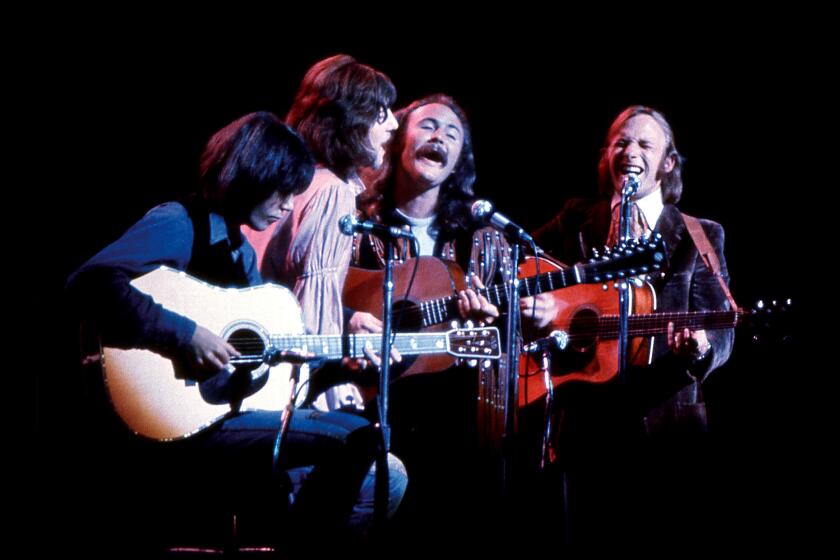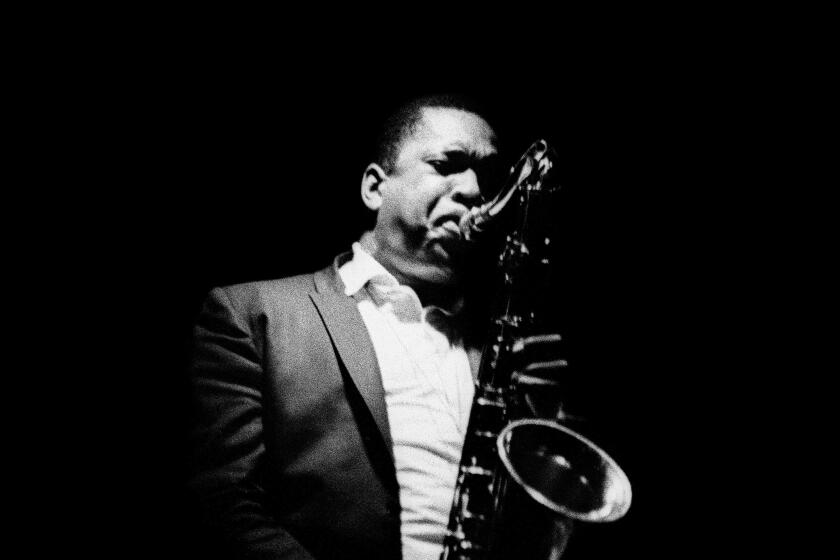MAKE WAY FOR BRAZILIAN SOUND : Musical Style Is on the Rebound 25 Years After Bossa Nova Boom
- Share via
Some things simply refuse to die. Take Brazilian popular music, for instance, which came to this country 25 years ago in the form of the bossa nova.
Despite its sensuous rhythms, persuasive melodies and provocative lyrics, the appeal of bossa nova diminished in the mid-’60s. Since then, Brazilian music in general has been an underground sound.
But today this musical style is on the rebound. With artists like Milton Nasciemento, Gal Costa, Ivan Lins, Djavan and Caetano Veloso as well as perennials like Antonio Carlos Jobim, Airto Moriera and Flora Purim slowly making their entrance into America’s musical awareness, there are murmurs of another Brazilian wave. Still, industry experts say, don’t expect anything like the bossa nova boom--at least not for the time being.
“It’s still in its infancy,” said Louise Velasquez, executive vice president of Quincy Jones Productions and one of the music’s chief proponents. “It may get to be as big as bossa nova, but only time will tell.”
Richard Seidel, vice president of Polygram Jazz, whose catalogue boasts such notables as Stan Getz, Jobim and Nasciemento, is cautiously hopeful. “While I think that there’s a larger audience for Brazilian product now than in recent years, I wouldn’t say it’s a full-blown movement,” he said.
Guitarist Lee Ritenour, who first recorded with Brazilian musicians in 1979, is more enthusiastic. “I feel the time is right for a big hit with a Brazilian tune,” he said. “The last few years have seen a lot of meshing of American and Brazilian styles and artists. The atmosphere is very healthy.”
Ritenour has a kindred spirit in Quincy Jones, who was first in Brazil with Dizzy Gillespie in 1956. “Brazilian music really stands toe-to-toe with American popular music in terms of serious lyricism, rich harmonic content and all-the-way rhythmic input,” Jones said. “Musically, we can’t escape it.”
Still, Brazilian music remains unfamiliar turf to a majority of American listeners, and record sales have yet to really ignite. “Though some LPs have sold as many as 500,000 copies in Brazil, in the U.S. the range is usually 5,000 to 10,000. Top artists like Djavan and Nasciemento sell about 25,000 to 30,000 LPs,” said Velasquez. “Until Brazilian music breaks big, the sales will probably stay at this level.”
From its beginnings with the 1962 Stan Getz/Charlie Byrd collaboration, “Jazz Samba,” the bossa nova--as recorded by such jazz musicians as Getz, Paul Winter, Herbie Mann, Cannonball Adderly and Gillespie created a furor that peaked in 1964. That year, “Getz/Gilberto” (Verve), featuring Astrud Gilberto’s silky, lilting vocal of Jobim’s “The Girl From Ipanema,” reached No. 5 on the Billboard charts and received Grammys as Record of the Year and pop Album of the Year.
Between 1964 and the current rise, Brazilian music maintained a low, but consistent, profile. LPs continued to sell, Brazilian tunes were heard in elevators and on radio, and jazzmen from Getz to Pat Metheny placed the catchy tunes on their albums.
It was in the early ‘80s, when Velasquez joined Quincy Jones’ Qwest Music--which has publishing rights in the U.S. to the music of Lins, Nasciemento, Djavan and others--that a solid effort was made to find new artists to record Brazilian material. The effort paid off, and soon many more pop and jazz artists were including either Brazilian tunes, artists or both in their projects. Among these have been Vaughan’s “I Love Brazil” (Pablo), Ritneour’s “Rio” (Elektra/Musician, re-released on GRP), George Benson’s “Gimme the Night,” Azymuth’s “Spectrum” (Milestone) Tania Maria’s “The Lady From Brazil” (Manhattan/Blue Note), Mark Murphy’s “Night Moods” (Milestone) and Jones’ own “The Dude” (A&M;).
The music should get a boost this year from such major projects as the Manhattan Transfer’s “Brasil” (Atlantic), Sarah Vaughan’s “Brazilian Romance” (CBS), Jobim’s “Passarim” (Verve) and Nasciemento’s CBS debut. The latter recording will spotlight Paul Simon on one track, dueting with the leader in Portuguese. Sources close to the field say the Transfer’s LP could spark the burgeoning trend.
One obstacle keeping Brazilian music from a wider audience has been a lack of airplay. Velasquez cites the problems with getting domestic airplay for Djavan’s “Luz,” which had already sold 500,000 copies in Brazil by the fall of 1984, when it became available here as an import.
“The CBS Spanish language division said, ‘No one will play this on the air,’ ” Velasquez said. ‘So I called (then-program director) Lawrence Tanner at KUTE-FM (now KMPC-FM). He listened to it and flipped, and immediately added it into heavy rotation, in the Portuguese. Then he played (the follow-up) ‘Lilas’ before it was released. This interest was an incentive for CBS (domestic division) to release the compilation ‘Djavan,’ comprised of tracks from ‘Luz’ and ‘Lilas,’ in 1986.”
Ritenour is another who thinks pop radio should give the new music a chance. “If the powers that be wanted to put (Brazilian music) on Top 40 radio,” he said, “I’ll bet the people would love it.”
The fact that most Brazilian artists are vocalists and sing in Portuguese presents a barrier that has yet to be hurdled. “A lot of distributors haven’t figured out where to promote it,” Velasquez said. “Their attitude is ‘If an artist is singing in Portuguese, a pop station won’t play it.’ ”
Seidel says that one key to new fans “is coming up with good English lyrics and artists who can convincingly sing them. And that’s not always the easiest thing.”
Ritenour disagrees, stating, “The Portuguese lyric is no problem. People hear the language as much as melodic rhythms as they do words and we as a culture are starting accept rhythms of the world more readily.”
Still, more English lyrics would please Jobim. “English is the richest language in the world because it has everything in it--from Italian to Chinese to Portuguese to Dutch,” he said. “You’ve stolen well.”
Increasingly, Brazilian artists are coming north to record in English. “Ivan, Djavan, Milton are all doing albums in English because they realize their time is coming in America, and Americans are tuning in, so why shouldn’t they take advantage?” said the Manhatten Transfer’s Tim Hauser.
In the past year, there has been an increasing supply of Brazilian music in local nightclubs. The artists include guitarist John Pisano’s Velas, Samambaia, Brazilian Secrets, Tropicalia and others. They can be found locally in such rooms as Donte’s, the Baked Potato, the Biltmore Hotel’s Grand Avenue Bar, Bon Appetit, At My Place, the Comeback Inn and Le Cafe.
Listeners seeking Brazilian LPs, most currently available only as imports, will find that stores such as Tower, Aron’s, Rhino and the Wherehouse carry enough to satisfy the curious.
There’s good reason why Brazilian music has always had some sort of following here, said Jobim. “There are only three countries that really swing: the U.S., Cuba and Brazil,” he said. “Other counties have beautiful music but they don’t have this beat, which is part of the African culture, which brought it to those countries.”
Hauser added: “You can feel that groove in Brazilian music, and I think that’s why so many people respond favorably to it.”
More to Read
The biggest entertainment stories
Get our big stories about Hollywood, film, television, music, arts, culture and more right in your inbox as soon as they publish.
You may occasionally receive promotional content from the Los Angeles Times.










